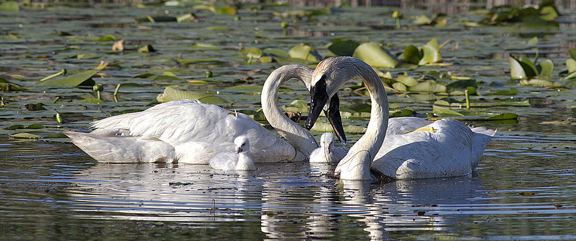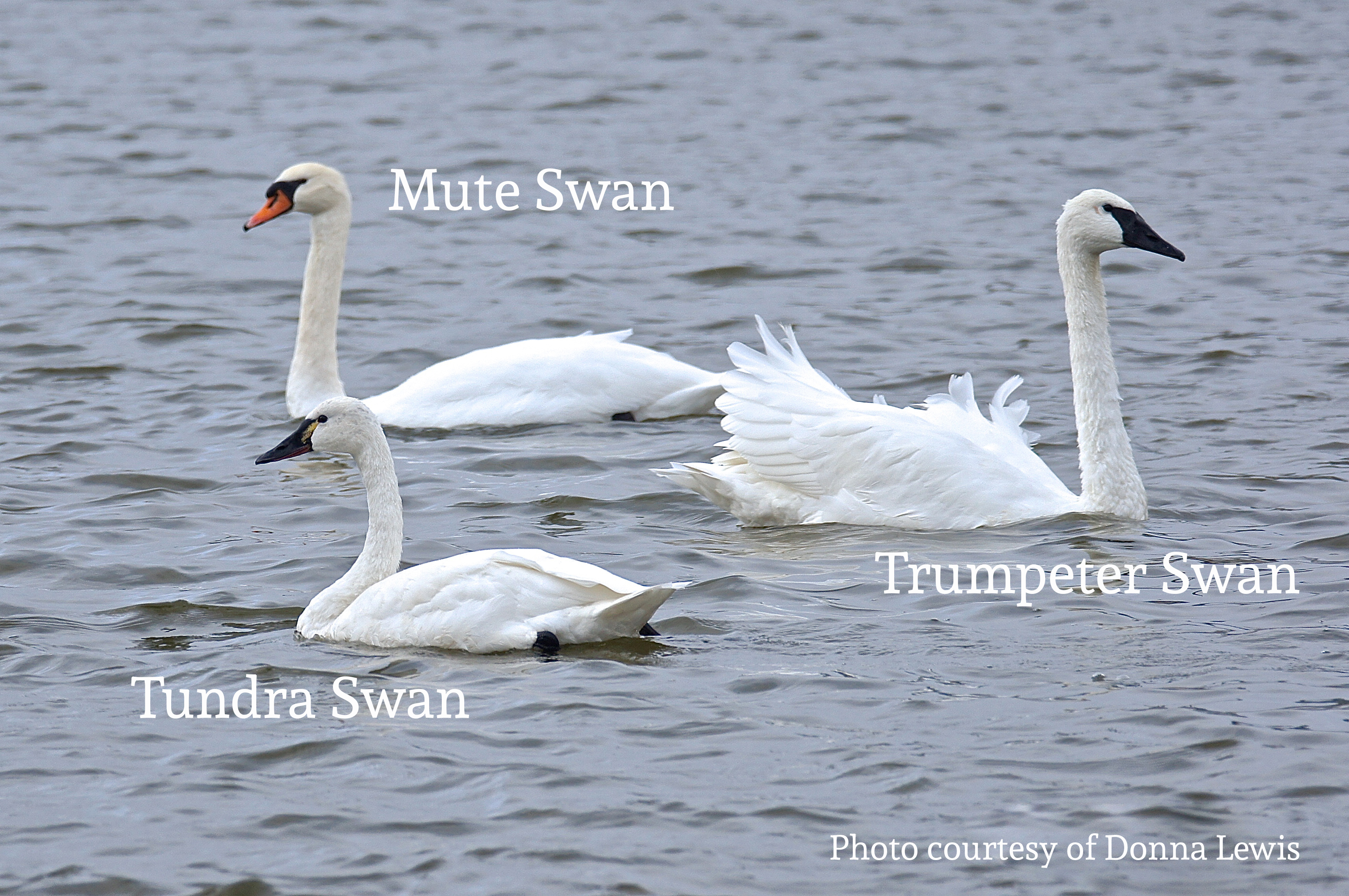Trumpeter Swans 101
Known for their white plumage and trumpeting call, learn more about Trumpeter Swans in Ontario.
Fun Facts:
- All swans form strong pair bonds, having the tendency to mate for life, but new pairing can occur.
- Male swans are called cobs, female swans are pens, and juvenile swans are cygnets.
- Trumpeter cobs (9-14 kg) are generally larger than pens (9-12 kg) but show no difference in colouration to help distinguish a male from female.
- Lead poisoning from ingested fishing tackle or spent shot, power line collision and human encounters remain the leading causes of adult swan death.
- Trumpeter Swans are the largest waterfowl in North America.
- Adult Trumpeter Swans can have a wingspan of up to 3 meters.
- Trumpeter Swans are not bothered by the cold. They have almost 35,000 feathers and their downy layer is 2 in thick.
- Trumpeter Swans have 25 neck vertebrae – that’s almost twice as much as giraffes, who have only 13.
- Trumpeter Swans live an average of 12 years in the wild, and can live for over 30 years.
- Sometimes the head and neck of a Trumpeter Swan is stained a rust colour as a result of iron deposits in the sediment and water in which the swan feeds.
- Trumpeter Swans feed on aquatic vegetation and wild grasses in their natural environment – bread is not recommended as a treat.

From Egg to Adult
Trumpeter Swans generally nest in marshes or shallow ponds with few trees. They build a nest in the open water for protection, but it is often screened by cattails or located in a secluded area. Trumpeters mate for life, and often return to the same nesting site year after year once a suitable site is chosen.
- Starting in April-May, nest building begins. Nest are built of cattails and sedges sometimes on a muskrat or beaver lodge.
- In April-May, depending on weather conditions, Trumpeter Swans lay an average of 3-8 eggs, laid every other day.
- Eggs are incubated 34 days by the female swan , and hatch in May-June. Hatchlings are grey and fluffy with pink feet and beaks.
- Young swans, called cygnets, eat aquatic plants and invertebrates during the early weeks. The herbivorous adults will consume invertebrates when they are found within the shoots and tubers they forage.
- Cygnets learn to fly at 3-4 months of age. At this time they are still grey but have molted their fluffy down for true flight feathers. Their feet and beaks are mostly black with some pink-orange mottling.
- In November, Trumpeter Swans migrate to wintering grounds; normally travelling as a family. By this time, cygnets have developed mostly black feet and beaks, and feathers remain mostly grey.
- Approximately 25% will have survived to 3 years of age. Those that do will molt into their full white adult plumage. Once 2-3 years of age, the now adult swans will start looking for a mate and forming a pair bond.
Different Swan Species:
Of the 3 species of swans found in Ontario, two are native species and one is a non-native species.

The Mute Swan (Cygnus olor) comes from Eurasia. It can be identified by its orange bill with rounded basal knob. During the breading season the ‘nob’ on the male’s bill will enlarge. They are not big singers but can make hissing and snorting type calls.
The Tundra Swan (Cygnus columbianus) is visually difficult to distinguish from the Trumpeter Swan (Cygnus buccinator). Tundra Swans are smaller and can have a yellow marking on their lore (area between the eye and the upper beak) and the black of their bill attaches to their eye narrowly; whereas the Trumpeter Swan can have a pink line on its lower bill, like lipstick, and the black of their bill attaches to the eye more widely and smoothly. The most distinguishing factor between these species is their songs. Tundra Swans have a whistling melodic trumpet song, which leads to their other name “Whistling Swan”, whereas the Trumpeter Swan song is loud, brassy, and vibrant.
Threats to Trumpeter Swans
Young Trumpeter Swans face many threats to survival. They are predated on by wildlife like mink, snapping turtles, coyotes, and birds of prey. Eggs are also actively preyed upon. Due to their large size and strength, adult Trumpeter Swans face few natural predators; but eagles, coyotes, and wolves can be threats. Habitat destruction, lead poisoning, power line collisions, and human interactions are the greatest threats Trumpeter Swans face today.
Lead Poisoning
- Swans foraging on vegetation in wetlands and grasslands unknowingly ingest pieces of lead from fishing tackle and spent gunshot. Although lead was banned in 1991, the poisonous material remains in the environment. Once ingested, lead dissolves in the swan’s stomach causing disorientation, lethargy, and organ failure. They suffer a slow and painful death.
Power Line Collisions
- Trumpeter Swans can fly 80 km/hr; at these speeds the narrow power lines become difficult to see and avoid. Collisions can cause broken wings, disorientation, electrocution, and death.
Human Interactions
- Although most people respect and support wildlife conservation, poaching is still present. Other lethal human interactions include collisions with cars, ATVs, and watercraft.
How you can help:
- Support wetland conservation and research.
- Consider volunteering at a wildlife rehabilitation centre.
- Report sightings to monitoring organizations such as the Wye Marsh Wildlife Centre.
- If you have concerns with the health of any wildlife, including Trumpeter Swans, reach out to a local MNDMNRF (Ministry of Northern Development, Mines, Natural Resources and Forestry) representative to expose unlawful actions, and wildlife rehabilitators for their medical treatment and rescue.


 Our Supporters:
Our Supporters:












